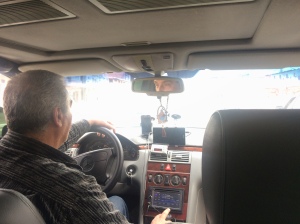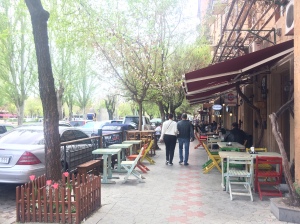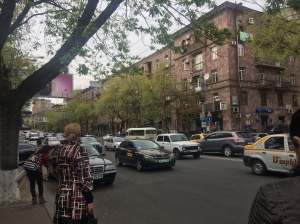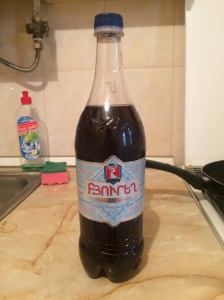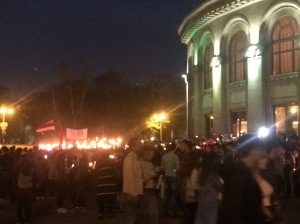I just got back from a weekend trip to Yerevan, Armenia. I’ve wanted to go to Armenia since my sophomore year of college. In spring 2009, I took a course in the politics of the ex-USSR. We studied the collapse of the Soviet Union and how it impacted each of the 15 republics, as well as many of the Eastern Bloc nations. A major component of the course was to spend a semester studying one of those nations. We had to write a research paper on them as well as make drafts of a Wikipedia page of sorts for the country. The professor told us that it would behoove us to choose a country that had a close history or political relationship with another country. The other country would be our partner, and we were supposed to help each other out. My good friend Lauren and I met to strategize and pick nations that we thought would work well together and wouldn’t be immediately chosen by others. Being a huge fan of the band System of a Down, I wanted to go with Armenia. For those of you unfamiliar with System of a Down, they’re a metal band from Los Angeles. Each of the members is of Armenian heritage. They played a great concert at Yerevan’s Freedom Square in 2015 for the centennial anniversary of the Armenian Genocide.
Lauren chose Azerbaijan, and our semester of research took off without a hitch. After spending months researching Armenia, I became fascinated by it. I even strongly considered applying for a Fulbright ETA to Armenia instead of Russia. Although Russia won out in that decision process, I had not given up on eventually going to Armenia. Thankfully, one of my fellow ASEEES grantees has been doing research in a few republics other than Russia. Erin was wonderful and let me visit her and crash at her place.
On Friday morning, I headed off to the airport. On the way out of the dorm, the strictest dezhurnaya, Olga, saw me leaving and asked why I was leaving so soon. She had evidently noticed that I had not been around for a few weeks and was confused as to why I was again heading out of the dorm at an early hour with a full backpack. I explained that I was going to Yerevan for the weekend to visit a friend researching there, and that I had to do the super quick turnaround due to Russian migration laws. When you travel within Russia, or return from abroad, you have to register your place of living. I traveled to Ulyanovsk when I did to make sure that I could see two of my best friends and to ensure that I wouldn’t have problems with migration concerning the trip to Armenia. I had booked the tickets to Armenia moderately far in advance with regards to Erin’s schedule. Immediately after returning from Kazakhstan, I handed in my papers at the university to register at the dorms. According to Russian migration laws, a foreigner has to register their visa within 7 business days in a new city. Then, when I traveled to Ulyanovsk, I registered at my friend Ira’s apartment. It takes me a week to get my registration from the university, as opposed to immediately if registering with a private citizen through a post-office or police station, so I knew I wouldn’t have time to reregister after Ulyanovsk before heading to Armenia. That’s why I decided to come back from Ulyanovsk on a Wednesday and fly out on a Friday, I wouldn’t have to bother with reregistering.
The flight left Sheremetyevo a little late, but we were scheduled to land early. The flight was mostly fine. It wasn’t quite the steal of $15 roundtrip to Kazakhstan, but the miles reward flight only cost me $50 roundtrip. We got the standard “breakfast” meal of a fish sandwich, yogurt, and chocolate bar with a drink. Around the time that they were serving me, we started to hit some light turbulence, so they stopped the hot drink service. After the meal service was cleaned up, we hit some moderate turbulence. You know it’s never a good sign when they tell the crew to take their seats. We were jostled fairly roughly for about five or ten minutes. After that, though, it was fairly smooth into Yerevan. My plane even had WiFi for streaming of entertainment on personal devises. There’s a reason why Aeroflot has recently become the top rated European airline.
The skies were clear, so I had a great view of the mountains, countryside, and city the whole way into the airport, which was pretty awesome.
Passing through customs was also a breeze. Although a few flights had landed around the same time, we moved through the line quickly and efficiently as there were about 15 customs officers working to process all of the passengers.
After making it through the airport, I met Erin and we grabbed a taxi back to her place. We managed to take the same taxi that had dropped her off at the airport. She had told the driver that she was picking me up, and he had given her his number and told her to call in case he was still around. To my glee, our taxi was a 1997 Mercedes W210. Erin spoke with the driver in Armenian, but he also spoke Russian, so I questioned him about his car a little. He seemed pleased that I was so interested in it. While on the topic of cars, Armenia was a vehicular paradise for me. Many of the cars are old Mercedes, mostly C and E classes from 1995-2003.
There are also a smattering of Baby Benzes, the W201, and a few of my beloved W124s, though those were rarer and are generally post-1990 face lift models. There were also a fair number of newer E Classes of the W211 and W212 models, a smattering of W140 S Classes, and a surprising number of Geländewagens. For the German car nut, Armenia is probably a place to travel to hunt what are becoming collector’s items in the USA and Europe. I saw a few 190Es plus some rarer tuned Mercedes. There were a handful done by Brabus or Carlsson. However, I’m not sure how legitimate all of these are. My taxi back to the airport on Monday was clearly modified. For example, the driver had affixed a gear knob that said V12, and the steering wheel was from a 2002 or so W210, and not 1998, which he said the model was. I’m also second guessing the authenticity of some of the W124s. A former neighbor from Ulyanovsk lives in Dushanbe, Tajikistan. He told me that it’s common to apply the newer body kits to the first generation W124s. He did that himself to his W124.
Mercedes were by far the German car of choice in Armenia, but there were also some great BMWs, including a drool worthy M3, and some Audis. Opels were also quite common on the streets. German cars made up either 1/3 or ½ of the cars on the road. The remaining models were split between Soviet cars, like Lada Zhigulis and Nivas, or my beloved UAZ and odds and ends of other companies from Europe, America, and Asia. I asked my driver back to the airport on Monday about all of the Mercedes in Yerevan. I wondered if there was a company that bought them wholesale and brought them in, but he said it was all private buyers who went to Germany and drove them back.
After dropping off my stuff at Erin’s apartment, we set off to explore downtown Yerevan and grab some lunch. Our first order of business was to walk down to the main street and hop in a marshrutka, which took us further into the center. In Armenia, the marshrutki are predominantly old GAZelle models. Unlike in Russia, you pay when exiting the marshrutka. Also, unlike in Russia, you can stand in the old model of marshrutka.
In the center, we headed to a hipster microbrewery. There is a vibrant Armenian community in Los Angeles, and it seems that some of LA has moved back to Yerevan. The microbrewery had excellent beers, one of which was an apricot wheat lager. Armenia is known for its fruits, one of which is apricot. The menu had sassy descriptions of trendy foods such as Tex-Mex and poutine. While I am generally missing Mexican food in Russia, I couldn’t help but order the poutine to troll my Canadian friends. It was delicious and I regret nothing.
Erin and I also ended up splitting a tasting flight of the local brews, all of which were great. In addition to the superb apricot beer, there was also a wonderful and tart cherry one.
From lunch, we wandered around one of the main squares of Yerevan, Opera, and then we popped into one of Yerevan’s many cafés to have a pick me up of coffee. Yerevan has a very European feel. It reminds me a lot of France, actually. There is a huge coffee and café culture. Everyone enjoys sitting out on the street, sipping coffee, and watching the crowds go by. Yerevan is also moderately accessible for a foreign traveler, especially one with knowledge of Russian. Most people over 30 are bilingual in Armenian and Russian. People under 30 seem to be bilingual in Armenian and English, or are trilingual with Russian.
Architecturally, Yerevan is also a mixture of Soviet and European. Although many of the older buildings are in the standardized Soviet five or nine-story blocks, they have their own character. There is a lot of volcanic stone in Armenia, the most common of which is in a pinkish hue. Most of the buildings are constructed of this local stone, so they don’t have the same depressing quality as the grey blocks of the rest of the USSR. Located on the periphery of the Soviet Union, it seems that Armenia was also granted some leniencies to allow its local culture to flourish. Again, which the buildings are in somewhat standardized configurations, they often had uniform and ornate balconies as well as embellishments such as carvings and columns. While this architectural style is often vaguely brutal in the terms of Stalin’s neoclassical style, in Armenia it makes everything look like a Mediterranean paradise.
From coffee, Erin and I relaxed a bit before changing, grabbing a taxi, and heading off to another one of Yerevan’s venerated traditions, a jazz club. We went to the most famous venue in Yerevan, Malkhas Jazz Club. There’s live jazz starting at 9:00PM nightly. We went and had a nice table with a decent view of the musicians on the ground floor. The band was great, and the food and drinks only added to the experience. I was able to get a perfectly cooked, rare filet mignon for about $10. The White Russian I had with it made it an evening of surprisingly affordable decadence. The cover charge, food, drink, water, and gratuity was less than $25.00 for me. That’s another nice and handy thing in Armenia. In most restaurants and cafés, a 10% gratuity is automatically applied to the bill.
On Saturday morning, Erin and I ventured out of Yerevan to two nearby and major sites. Her landlord gave us the number of a taxi driver, who took us out and back for about $25.00. He picked us up from the apartment, which is actually right next to his usual corner taxi stand, and drove us about an hour out of the city along the winding roads of the countryside to Garni and Geghard.
The countryside in Armenia is simply stunning. Yerevan itself is built at the base of and then up a mountain. We drove up the mountain and then found ourselves riding along road paradise. I would love to rent a car and drive around the back roads for a week or two. Unlike in Georgia, the drivers seemed fairly calm and more or less respected the lines on the road and kept to reasonable speeds. Along the road, we passed stands selling local food delicacies, small villages, dacha settlements, and a very interesting farm fresh butcher. There was a shepherd with a pen of sheep. You could pick out the sheep and the guy would kill, skin, and cut it for you on the roadside. Farm fresh eating indeed. Sadly, I didn’t manage to catch a picture of that.
The first place we went was the Temple of Garni. It was probably built in the First Century AD to a sun god. It was repurposed into a royal residence after Armenia’s conversion to Christianity. According to Wikipedia, it was ruined in an earthquake in the 17th century, and was later rediscovered during archeological digs. The Soviets reconstructed in the 1960s and 1970s, and it’s the only Greco-Roman colonnade building in the former Soviet Union. The temple itself was pretty impressive, but the views from it of the mountains, valleys, and rivers were stunning.
While walking back to the taxi, we popped by the stands of local food vendors and acquired a few provisions for our travels. We bought a fruit leather called T’tu Lavash or Lavashak. Basically, fruit is cooked down with water and then spread out to bake, traditionally in the sun. Think of it as an all-natural fruit roll up. I believe we got a pomegranate one. We also got a second one that was apricot that had walnuts rolled up with it. Finally, we got a traditional bread that’s frequently sold at Garni and Geghard called Gata. It’s a sweet bread, and the local variant is filled with something called koritz. It has the consistency and almost the taste of marzipan, but it’s just flour, sugar, and butter.
Armed with snacks, we got back into our taxi and rode to Geghard, which is a monastery complex that’s partially carved out of a mountain. 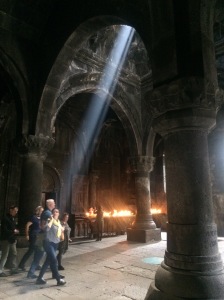
The complex was founded in the 4th Century and the main chapel was built in 1215. Perhaps few know the religious history of Armenia. The Armenian Apostolic Church was founded in the 1st Century AD, and Armenia was the first nation to adopt Christianity as the state religion in 301 AD. In comparison, the Roman Empire Christianized under Constantine the Great during his reign from 306-337 AD and it only became the state religion by the end of the 4th Century. Kievan Rus’, a predecessor of the Russian Empire Christianized in 988.
We wandered around the various caves and chapels in the complex before having a picnic in the shade on the back side of the territory. The monastery was pretty austere.
Many of the monks lived in little cells that were hewn out of the mountain. Being fairly isolated from society, the monks took to harvesting honey for nourishment. This tradition continues to this day, and there are a ton of bee hives around the territory of the monastery.
After our picnic, we rode back into the city and rested for a bit before walking into the center of Yerevan. We walked around one of the other main sites, the Cascade, before grabbing dinner at a Caucasian restaurant called Kavkaz that had a mixture of Armenia, Persian, and Georgian foods. We split a delightful khachipuri; a dolma platter (pronounced tolma in Armenian) which included stuffed cabbage, peppers, eggplant, and tomatoes; and a meat, potato, and spice dish called ker u sus that translates along the lines of “shut up and eat.” Everything was delicious and I was too busy stuffing my face to remember to take a photo of the meal. We also had a cool yogurt drink called Tan. It’s basically just watered down yogurt, and it’s super refreshing and cooling, especially in the hot weather. Coming from Moscow, it was indeed hot in Armenia. When I left Moscow, it was around freezing, and it was in the 70s during the day each day in Armenia. It was a treat to walk around in short sleeves and to sit outside for most of our meals.
After dinner, we headed to a rock club called the Stop Club to catch a band playing covers of 70s hard rock. They were pretty good. They played the Rolling Stones, Deep Purple, and the Doors among others. The mostly stuck to bluesy hard rock.
On Sunday morning, we had a later start and walked into the downtown for brunch outside at a wine restaurant before making our way up the Cascade.
With the inside of the Cascade is the Cafesjian Center for the Arts. The museum is broken up into five levels that go up and into the mountain. On each level, it’s possible to walk out onto the Cascade and get different views of the city. It’s also a convenient way of heading up the mountain. The last few flights have to be done on foot.
At the peak, there is the Monument to 50 Years of Soviet Armenia, as well as a planned but still unfinished space for the expansion of the monuments and museum space of the Cascade.
From the top of the Cascade, it’s a quick walk over to Victory Park, which has a variety of war monuments ranging from those who died during WWII to the Soviet Invasion of Afghanistan. The highlight of Victory Park is the Mother Armenia statue, which originally was a statue of Stalin that was only taken down in 1967.
One cool part of this Victory Park is that no one seems to care if you climb on the military hardware on display around the base of the Mother Armenia statue. One piece of hardware is a T-34 tank, which was the main Soviet tank of WWII. It was the first tank to use sloped armor, and is sometimes known as the tank that won WWII. I, naturally, never pass up the opportunity to climb one if it is offered. It’s dissertation research at this point.
We then took a marshrutka back down into the city so that we could take a ride on the Yerevan Metro. The marshrutka was already full, so we had to stand for the ride down the hill, which was a little unpleasant. The driver was speeding, and I made the mistake of looking at his instrument cluster. What I found was a series of broken gauges. The rev counter was stuck at 5,500 RPM, the speedometer didn’t function, and the needles were missing from the fuel and oil gauges. Thankfully, we arrived without harm, and hopped into the metro. It was opened in 1981, and looks like most Soviet metros. It is built with the simpler caterpillar design of halls, but they are moderately ornamented with national themes. 
The cars themselves are the standard 1970s design that continues to run in Moscow and Tbilisi, but like in Tbilisi, the cars have been renovated recently with investment from the European Union.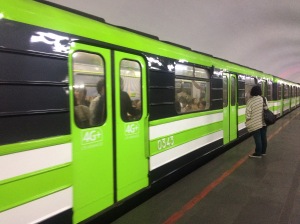
While not as frequent as the Moscow Metro, trains run every 5 minutes.
From the Metro, we walked back to Erin’s place with a quick pit stop at a vendor by her street. I had noticed a man selling homemade wine and spirits out of the back of his Lada. He was selling them in recycled water and soda bottles.
I asked what he had to offer. He had a variety of flavors of wine including raspberry and cherry. He offered a sample of the raspberry wine, which I bought a bottle of for about $3.00.
Erin and I then relaxed and had some wine in her apartment before walking into the center for dinner at an Indian restaurant. Stuffed to the gills with butter chicken, lentils, and nan,we walked to the second main square of Yerevan, Freedom Square, via a quick stop at Opera Square again. We saw the start of a rally on the eve of Genocide Remembrance Day. We didn’t quite catch the start, but people had gathered for a candlelight vigil before marching off somewhere else in the city.
Freedom Square was nicely lit up at night, and they have a fountain, light, and music show in the evenings called the Singing Fountains, which we watched for a while. The song choices were quite eclectic. When we approached the square, we heard Elgar’s “Pomp and Circumstance” before also hearing Wing’s “Live and Let Die,” “The Circle of Life” from the Lion King, and Donna Summer’s “Hot Stuff.” From Freedom Square, we hopped back on the Metro and went home for an earlier evening.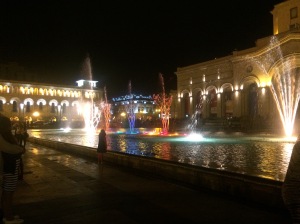
On Monday morning, we woke up early so that we could attend the traditional ceremony for Genocide Remembrance Day. April 24th is a holiday in Armenia for that cause. From 1915 to 1923, the Ottoman Empire launched a genocide against its Armenian population. The arrest deportation of Armenian intellectuals, which started on April 24, 1915, is seen as the starting date of the Genocide. Every year, Armenians gather at the Armenian Genocide Memorial at Tsitsernakaberd to walk up the hill to the monument and lay flowers inside the memorial. One of Erin’s Armenian friends said that we should get there around 8:00 to avoid waiting for a very long time. We got up and walked to the taxi stand at the end of Erin’s street and found a nice man with a W140 S Class to drive us as far as the bridge that leads up to the memorial complex. Some of the roads were closed to regular traffic to accommodate the large crowds heading to the memorial. Incidentally, this was the first time that I got to ride in a W140, so I was pretty excited. I was not excited, however, when the driver used most of the power of the V8 engine to rocket us down the hill while his break wear indicator light was on. My only consolation was that these cars are absolute tanks, and unlike in Georgia or Central Asia, the seatbelts in the backseat were still installed and functioning.
We walked across the bridge and found a flower vendor near the base of the complex. We climbed up the hill with the crowds and eventually wound up in a fairly large crowd at the top of the hill to wait our turn to enter the memorial and lay our flowers around the eternal flame. The ceremony was understandably a very big deal, and a variety of news outlets were televising the procession.
The event was also incredibly well organized. The crowd was funneled up the complex to the monument along one main path. From the top, the crowd was then taken down to the other side along a different path. At the base of the path, there were free busses, which were there to take people either back to the other side of the memorial or to one of the metro stops, which we rode on back to Erin’s neighborhood. We then walked back into town for a brunch at a café where I had something that more or less approximated a ham, egg, and cheese sandwich on a bagel. We then strolled back to her apartment with a stop via a nice bakery for some cookies.
After a quick drink of a little more of the raspberry wine, we headed outside for my taxi back to the airport. We had arranged with the guy who drove us to the Genocide Memorial for a taxi to take me to the airport. The guy was supposed to be at the apartment at 12:15, but when he wasn’t there around 12:30 we deiced to call a taxi through Armenia’s version of Uber, GG Taxi. At the same time that the GG Taxi arrived, the other driver showed up. He was slightly annoyed that we had called a GG Taxi, but it was his loss for showing up about 20 minutes late for a ride to the airport. I was also not so secretly happy to get to ride back to the airport in a 1998 W210.
I had already checked in for my flight, so I just had to wait in line for a short bit to get a boarding pass. Immigration control once again went very quickly with the 20 or so kiosks that were set up to process travelers. The terminal itself is fairly new and quite small. There are about six gates, a few kiosks for food and drink, and newsstand, and great lounge chairs with views of the runway, Mount Ararat, and free WiFi.
Although our plane boarded a few minutes late, we pushed back from the gate 2 minutes ahead of schedule. The flight was calm after some light turbulence around takeoff, and we landed in Moscow 20 minutes ahead of schedule. I made it through immigration reasonably quickly and without issues and was back in my dorm well ahead of my 9:00PM laundry slot. And so concludes a the trip to my 6th ex-Soviet Republic.

